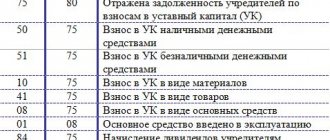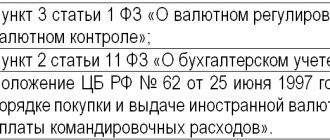- What is a foreign currency current account, how does it differ from a ruble account?
- Top 10 banks for opening a foreign currency account
- How to open a foreign currency current account in a Russian bank?
If all subjects of the Russian Federation are required to conduct transactions among themselves only in Russian rubles, then it may not be enough to work with foreigners.
Here you need a current account in foreign currency in order to receive transfers to it in monetary units of other countries, store these funds there and conduct foreign exchange transactions, namely, payments and transfers to foreign counterparties and exchanging currency for rubles within the country. Foreign exchange current accounts are usually opened in US dollars or euros, and more and more offers are being made in Chinese yuan. Japanese yen, pounds sterling, Canadian and Australian dollars, Danish and Norwegian kroner are usually in demand as current account currencies only by firms that have direct permanent transactions with these countries. Many enterprises and individual entrepreneurs have to evaluate Russian banks for opening a current account, taking into account possible transactions with specific countries.
Paying an invoice in foreign currency: nuances and limitations
There are 4 ways to make paying an invoice in foreign currency as simple as possible:
- Opening a special foreign currency account in a credit (banking) organization.
- Payment without a special invoice directly to the specified addressee.
- Transfer via electronic banking system.
- Using the terminal.
When using remote banking, it is necessary to take into account the commission directly for the transaction performed, % for transferring money between wallets (for exchange transactions).
Remember, anyone can top up a card account, but you can top up a foreign currency account.
Creating a transfer order in foreign currency - step-by-step instructions
Having understood the technology and the nuances of processing a transfer, let’s consider the process of creating a currency order (instruction) step by step:
- We go to the client bank and select the options “Documents” - “Currency orders” - “Create payment order”. Interfaces may differ slightly in different client banks, but the standard path to creating payment documents usually goes through the “Documents” (or “Payment Documents”) menu. In this case, the number and date of the order are usually assigned automatically. Some systems may offer to choose whether the payment will go to another bank customer or to another bank. To create the transfer in question, you need to select another bank. Typically, at this stage, a transaction parameter is indicated - the deduction of bank commissions for the transfer. To do this, you need to select the appropriate value in the corresponding field in the drop-down list. Based on the available list, it will be clear which commissions can be deducted and how they can be withheld; in addition, the options can be clarified with the bank, so we will not dwell on this point in detail in the format of an article.
- In the appropriate fields, indicate the currency code and payment amount. In some cases, a simultaneous conversion option is available. For example, if the payer has money in rubles, and the payment needs to be made in dollars, you can make o. The bank, executing the order, converts the funds into the required currency.
- In the field for specifying the debit account, select the corresponding client account. In this case, the remaining details are entered automatically from the information stored in the system. Usually at this stage the document also includes those details that the bank requires to comply with the provisions of Law No. 115-FZ. In addition, the SWIFT code of the payer’s bank is usually automatically entered (if you selected a transfer to another bank in step 1).
- We indicate in a separate field the SWIFT code of the intermediary bank (if it is in the details provided by the counterparty). Next, the system itself will find all the other necessary information about the bank using the code. The same will happen if you indicate the clearing code instead of SWIFT (there is a separate field for this). If there is neither one nor the other, all fields will have to be filled in manually: address, bank name, city, country. Some client banking systems may return a payment without an identification code “to clarify the details.”
IMPORTANT! Both SWIFT and clearing code are selected from international directories. That is, next to the code field there should be an icon for a drop-down list of banks with codes.
- We indicate the details of the beneficiary's bank in separate fields (similar to the intermediary bank).
- In the appropriate fields we indicate the details of the payment recipient. All suggested fields must be completed. If there are IBAN and BEI codes, we start with them. It is possible that the fields “Recipient Name”, “City” and “Country” will be pulled up from the directories themselves.
- Fill in the “Purpose of payment” field. For international transfers - Latin. The use of English standardized code words is permitted.
NOTE! In some systems (for example, Sberbank), information about transfer fees is included in the payment order after specifying the purpose of the payment (and not in the first steps, as is standardly presented above).
- Next, we fill in the fields necessary for Russian currency control: for example, a transaction passport.
NOTE! To include a transaction passport in an order, as a rule, it should first be separately entered into the client bank in the “Documents” section. Then, when generating a payment, a drop-down list with information about the passports available in the system will appear in the “Passport” field. Accordingly, all that remains is to choose the one you need.
To specify additional information for bank control, see the article “How to indicate a currency transaction code in a payment order?”
- We save the currency payment order (the “Save” button). At this stage, the system will conduct a preliminary check and issue comments in case of errors. The saved document can be signed and sent for execution.
In which currency is it more profitable to open an account?
Factors that have a direct impact on the upcoming choice of currency servicing the account:
- output tools;
- service centers;
- the purpose of the account;
- price for exchange and other transactions.
When going to Europe, consider which currency is in priority in the selected country, understanding in which currency to open an account? It is better to navigate by the duration of use of the currency.
In Poland, both dollars and euros are equally useful to you, in France – dollars, in Germany – euros. The manager of the financial institution will justify several proposals and you will make significant savings.
Where to open an account in foreign currency?
You can legally open an account in foreign currency at any accredited bank. Prepare:
- Passport.
- Template statement.
- Amount for the minimum deposit.
You may need less money, but usually around $5 is required. They are the account activator and belong to the account owner. The procedure takes 2-7 minutes.
A universal account may be offered. Thanks to this, you will have trouble-free payments in foreign boutiques, shops, and salons. Remember, you must receive the appropriate card (Visa, Master Card).
Based on the law, you have the right to create several personal accounts. The use of different accounts serves as a risk diversifier and is often practiced by domestic entrepreneurs.
What to do if the account is in foreign currency, payment is in rubles?
A similar question may arise not only when settling with a regular seller, but also with a supplier during wholesale shipments. The contract may provide for various payment options convenient for legal entities.
As a rule, the technique is used during a crisis or force majeure. You have been provided with an account in foreign currency, and payment in rubles is more convenient for the company. Pay for the goods at the current rate.
A separate clause of the contract may provide for other conditions with the exchange rate fixed at a specific date. Thus, the difference in the payment amount occurs when the payment is divided into parts and does not exist when making a one-time prepayment.
An enterprise can reflect the difference in revenue in the “Amount Differences” subaccount, helping the accountant see the source of discrepancies in tax and business accounting.
Sample currency payment order
For those who will have to fill out an instruction for a currency transaction not in the client bank, but manually, we suggest that you familiarize yourself with a sample of filling out such a document.
At the same time, we remind you that in the form that a particular bank will actually offer to fill out, the location of some columns may be changed, and additional columns or sections may be introduced for information that this bank considered necessary.
For example, in the proposed sample there is no separate table “Information for currency control,” which can often be found in forms issued by banks. In essence, such tables combine and duplicate in Russian the information that is already in the completed mandatory columns of the payment order. Filling them out, as a rule, does not cause any difficulties.
Who can make a currency transfer without opening an account?
Any citizen can make a currency transfer without opening an account in the Russian Federation. However, only non-residents can transfer foreign capital. For the latter persons, the transaction amount is unlimited.
Russians transfer foreign currency using a special foreign currency account.
For a regular internal translation, it is enough to know:
- recipient details;
- bank details;
- department number.
Remember, payments between legal entities, non-residents and residents can only be made by non-cash method.
Paypal: account currency and conversion features
When engaging in trading on online platforms, entrepreneurs and individuals are often faced with the fact that payments are quoted only in USD.
Our compatriot has to pay twice for purchasing currency in Paypal:
- When debiting an amount from a ruble account.
- When performing a mutual settlement transaction between counterparties.
There are three ways to avoid loss:
- offer your partner another option for mutual settlement;
- write to Paypal technical support: the account currency is not identified correctly;
- include the difference in the price or receive a discount equal to the financial loss from the transaction.
Account currency designation
There are many currency classifiers. They can be global, interstate (for example, between the countries of the Customs Union), national, or sectoral. The global designation of account currency is regulated by the ISO 4217 standard. The standard establishes a three-character designation. For currencies, three letters and three numbers are used (for example, RUB and 643 for Russian currency, USD and 840 for American currency). ISO4217 is used in international transactions, as well as documents and related messages, in banking and simply commercial activities as an abbreviation. The current standard is designated ISO 4217:2008.
Transactions on a foreign currency account
Operations on a foreign currency account can be carried out by its owner or a representative (authorized representative) of the owner. These include:
- transfer of funds to another person (legal or individual);
- receiving funds from a resident or non-resident of the state;
- transfer of funds from one currency to another.
Article 9 of Law No. 173 of December 10, 2003 defines cases of legal
conducting transactions with foreign currencies between residents of the Russian Federation. Operations in other situations are considered illegal. Transactions between a resident and a non-resident are possible.
How do you receive funds into a foreign currency account in a Russian bank?
After a resident of the Russian Federation receives payment for goods, services rendered or work under an agreement, act or other official document, foreign exchange earnings are generated. To transfer and legalize it, you should open a special bank account (current, transit and special transit).
Next, the algorithm of actions is as follows:
- a notification is sent to the Federal Tax Service about opening an account - if the deadline for filing a notification is violated, the law provides for fines of up to 5,000 rubles;
- each separate account requires a separate notice;
- You should also report the accounts of branches (for legal entities);
- a package of documents is submitted to the bank to legalize the amount received (usually a contract and its copy certified by a notary are sufficient);
- if the transaction amount is more than $50,000, the bank issues a transaction passport (TS).
There are several reasons why a bank refuses to formalize a transaction agreement and, therefore, to recognize foreign currency earnings as legal:
- discrepancies in information in the contract (agreement) and the PS;
- failure to comply with legal requirements regarding permitted foreign exchange transactions;
- incorrect registration of the PS;
- the absence in the contract (agreement) of a clause stipulating the fact of receipt of funds to the account;
- lack of certified translation of contract documentation.
For each owner of a foreign currency account, after registration of the PS, a so-called resident dossier is compiled, which records all transactions on funds crossing the border in one direction or another.
For law firms, the dossier contains the following documents:
- transaction passport (in original);
- notarized copies of the contract;
- product registration cards;
- a copy of the customs declaration for the cargo certified by a notary;
- other documents related to the export or import of products.
You can find out a detailed list of required documents in the help desk of a particular bank.
Purpose of a foreign currency account
The main purpose of a foreign currency account is transactions with foreign currency. This may include accepting payments and paying for services/goods to a resident or non-resident of the Russian Federation, lending, accumulating funds, or playing on exchange rate differences. In the business sphere, it is opened for transactions with foreign counterparties, short-term lending (up to 180 days), direct or portfolio investment in business projects, as well as for other purposes.
The account can be intended only for transferring funds, or for accumulating and receiving dividends from the bank.
Currency risks
The use of foreign currency accounts involves risks due to changes in interest rates and exchange rate fluctuations. These factors influence all participants in foreign exchange transactions.
Banks risk receiving less profit or even suffering losses from deposits as a result of the result of a foreign exchange transaction. To minimize such risks, financial institutions make additional write-offs on transactions as a result of the revaluation of the foreign currency account.
Holders of foreign currency banking products risk receiving less money than they invested, which is explained by changes in the exchange rate and the presence of additional deductions. They must take into account potential risks and respond promptly to changes in the conditions of service, as well as in the political and economic situation in the country.
Types of currency accounts
There is no separate group for foreign currencies, and banks can open any accounts in rubles, dollars, and euros. The main types of foreign currency accounts are current (for individuals), settlement, budget, correspondent, deposit - for individual organizations, special. There are also trust management accounts, separate ones for courts, notaries, bailiffs, and law enforcement agencies.
Accounts for deposits are opened for storing and accounting for funds placed in the bank for the purpose of accumulating and generating income.
Account 52 “Currency accounts”
Account 52 “Currency accounts” is used in accounting to designate accounts opened in foreign currency and record the movement of funds on them. They are used for transactions with foreign counterparties and repayment of loans. Cash can only be used to pay for business trips abroad. With some exceptions, foreign currency accounts can only be used for transactions with residents of other countries.
Legal entities registered in the Russian Federation may have a foreign currency account in any foreign bank. Transactions on it are also recorded in reporting.
Settlements in foreign currency on the territory of the Russian Federation between residents and non-residents
With regard to settlements between Russian and foreign companies and individuals, Russian legislation contains a minimal restriction (Article 6 of Law No. 173-FZ). There is no ban on making such payments; transactions are carried out through foreign currency accounts, including those opened by foreigners in Russian banks. All these operations are subject to currency control with the provision of documents on foreign economic activity to the credit institution, while the bank has the right to suspend operations on the account until the necessary documents are provided.
The restriction is established only for transactions of purchase and sale of foreign currency and checks (including travel checks), the denomination of which is indicated in foreign currency - in the Russian Federation they are carried out between residents and non-residents only through authorized banks and the state development corporation "VEB.RF" (Art. Law No. 173-FZ).
For companies, payments in dollars in the Russian Federation are a thing of the past; the modern legal framework strictly limits the use of currency for commercial purposes. However, practice shows that fairly strict currency regulation practically does not interfere with businesses operating legally and guarantees a stable economic situation in the country.
Foreign currency accounts of legal entities
Foreign currency accounts of legal entities can be opened in Russian or foreign banks. These include settlement, correspondent, special, deposit, and transit accounts. The main types of special accounts: “F” (for granting and receiving loans from non-residents), “P1” (for loans and borrowings, purchase and sale of securities, bills), “P2” (for sale and purchase of securities, as well as additional calculations).
A legal entity has the right to issue a line of credit in a foreign or Russian bank in foreign currency.
Payment of foreign bills: documents, features of transactions with foreign banks
Any legal entity, as its business expands, faces problems associated with entering the international market. Foreign counterparties open up new prospects for increasing income, although the proceeds come in foreign currency. We will tell you about the intricacies of working with foreign partners, as well as methods of paying foreign bills.
Where to begin?
An invoice from a foreign counterparty may be issued for goods supplied, services provided or work performed. In this case, for payment you need to transfer a certain amount in the currency of a foreign country. For these purposes, you should open a foreign currency account at a bank.
The package of documents required by employees when submitting an application differs little from what is required to open a regular account. The main thing is to obtain a list of required papers in advance - it may vary depending on the internal rules of the banking institution, as well as the specifics of the legal entity’s business.
After opening the account, the money is transferred to the recipient's details. In this case, they are first blocked on a transit account - a temporary account owned by the bank - to verify the legality of the transaction. Depending on the amount of the transfer, the bank has the right to request documents confirming the fact of the transaction (for example, show a contract or invoice on the basis of which the money is sent abroad).
Transit currency account and features of its operation
If the legality of the transaction is suspected, the funds in the transit account are blocked. To avoid this problem, you should carefully study the features of the temporary account.
Money is credited to the transit account for transactions related to:
- import and export of products;
- cargo or liability insurance;
- transportation and delivery of goods;
- payment of commissions to customs services and credit organizations.
The registration of a transit account occurs simultaneously with the opening of a foreign currency account. Moreover, it is used not only for settlements with foreign partners, but also when conducting transactions within the country using foreign currency.
The law determines the maximum period for holding money in a transit account - it should not exceed 15 calendar days. During this time, you must provide all the documents required by the bank so that the money is sent to the recipient’s details:
- the account owner's order to write off funds is drawn up on a special form of a specific bank;
- certificate of currency transactions;
- documents confirming the transaction - contract, specification, invoice, certificates of completed work, etc.
Note! All documents must be valid at the time of inspection. For currency control services, the bank charges a commission stipulated in the cash settlement agreement.
If the transaction amount exceeds $50,000, a transaction passport is required (issued by bank employees and includes information about the sender, recipient, as well as details of the future transaction).
Documents for opening a foreign currency account
To open a new account, a legal entity provides the bank employee with the following package of official papers:
- constituent documents;
- tax registration certificate;
- certificate of state registration as a legal entity;
- notarized sample signatures of all officials authorized to manage the account (if these persons are present at the bank at the time of submitting the application, then notarization is not required).
If any of the required documents cannot be presented in the original, the bank is allowed to take a copy certified by a notary (if the original is available, a bank employee can also certify the copies).
After opening an account, you must inform the tax authorities at the place of registration of the legal entity within 15 days. Otherwise, penalties in the amount of 5,000 rubles are possible.
Usually there is no fee for opening a new foreign currency account, but you will have to pay for servicing transactions on it. The total amount depends on the amount of money turnover.
Features of drawing up an agreement with foreign companies
When transferring funds to foreign accounts, the bank must request documents confirming the fact of the transaction and the purpose of payment. It is important that the documents are drawn up in two languages, especially in those sections relating to payment details.
Attention should be paid to the agreed deadlines: if they are violated, problems arise with the currency control service.
Moreover, it does not matter who is holding back the money - a Russian company or a foreign organization. Fines associated with violation of deadlines can reach 1/150 of the refinancing rate.
The percentage is calculated on the total amount of the foreign transfer, and is accrued for each overdue day.
Another important point is the condition under which the transaction is considered closed after fulfilling the conditions specified in the contract. This will allow you to do without “closing” papers, which will significantly facilitate making payments through the bank (especially for large payments for which a transaction passport is drawn up).
Registration of contracts
From March 1, 2021, banks are required to register all agreements that provide for payments to foreign accounts in the amount of more than 3,000,000 rubles (for imports and loans) or more than 6,000,000 rubles (for transactions related to exports).
To register, you must provide papers related to the concluded contract, as well as the recipient’s details, to the banking institution. The list of documents depends on the specifics of the transaction - it can be requested from bank employees for each specific case.
Registration deadlines do not exceed one working day. At the same time, the bank has the right to refuse the service if incorrect information is provided or the documents are not valid on the day of the transaction.
Important! The bank does not have the right to require documentary confirmation of the transaction for settlements in an amount less than 200,000 rubles.
VAT payment
If payment on an invoice concerns the supply of goods, provision of services or performance of work abroad, it is necessary to pay VAT to the budget of the Russian Federation. In this case, the money is not collected from the foreign partner, but from the resident of the Russian Federation - the money is withheld at the time of transfer according to the recipient’s details.
Moreover, the requirement applies to both individual entrepreneurs working on the simplified tax system and legal entities on the special tax system. Therefore, when making calculations, it should be taken into account that 18% is added to the amount specified in the contract or invoice to pay Russian taxes.
Legal entities on the OSN are allowed to reflect this expense item in the VAT return in order to subsequently return it from the country’s budget in the form of a tax deduction. Individual entrepreneurs operating at a rate of 15% (that is, income minus expenses) can record the amount in the “expenses” section to reduce the final tax amount. However, you should still prepare and submit a VAT return on time.
Source: https://bilderlings.com/ru/blog/oplata-inostrannyh-schetov/
Foreign currency accounts of individuals
Foreign currency accounts of individuals can be current or deposit, and if the person is an individual entrepreneur - also settlement. In addition, there are multi-currency accounts that allow you to exchange currencies without fees or delays.
They use this banking instrument to save funds, make a profit on a deposit or by playing on the difference in rates, to obtain and pay a loan, and various calculations. You can withdraw cash in rubles, after conversion at the current rate, and in some cases - in foreign currency.
Individuals also have the right to open an account in a foreign bank.
Features of passing a transit account
The instructions published by the Central Bank back in 1992, as well as subsequent amendments, introduce the obligation for legal entities and individuals to credit any proceeds received from abroad to a transit account. To do this you need to submit:
- certificate of currency transactions;
- application for transfer or sale of funds from a transit account;
- justification for the amount received (agreement or contract, certificate of completion, invoice, etc.).
Note! If the basis for the transfer is an agreement with a specified amount of more than $50,000 (or equivalent), it is necessary to additionally issue a transaction passport with the assignment of an individual number and endorsement by the banking service. The law defines the deadline for registration - no later than 2 weeks from the date of receipt of funds. It is also attached to the above documents.
After checking the papers, the bank either unblocks funds for further transactions, or requests additional information (or permanently blocks funds in case of suspicion of the legitimacy of the transaction). It is important that each time funds are credited, the bank receives a certain remuneration (commission) for carrying out currency control functions.
If the check does not reveal any violations, the client can sell the foreign currency amount or transfer it to a current account.
Important! Since exchange rates are constantly changing, all foreign currency accounts are subject to regular revaluation of balances in terms of rubles. Exchange rate differences arising during transactions are credited to the account in the form of debit or credit orders (advice notes).






